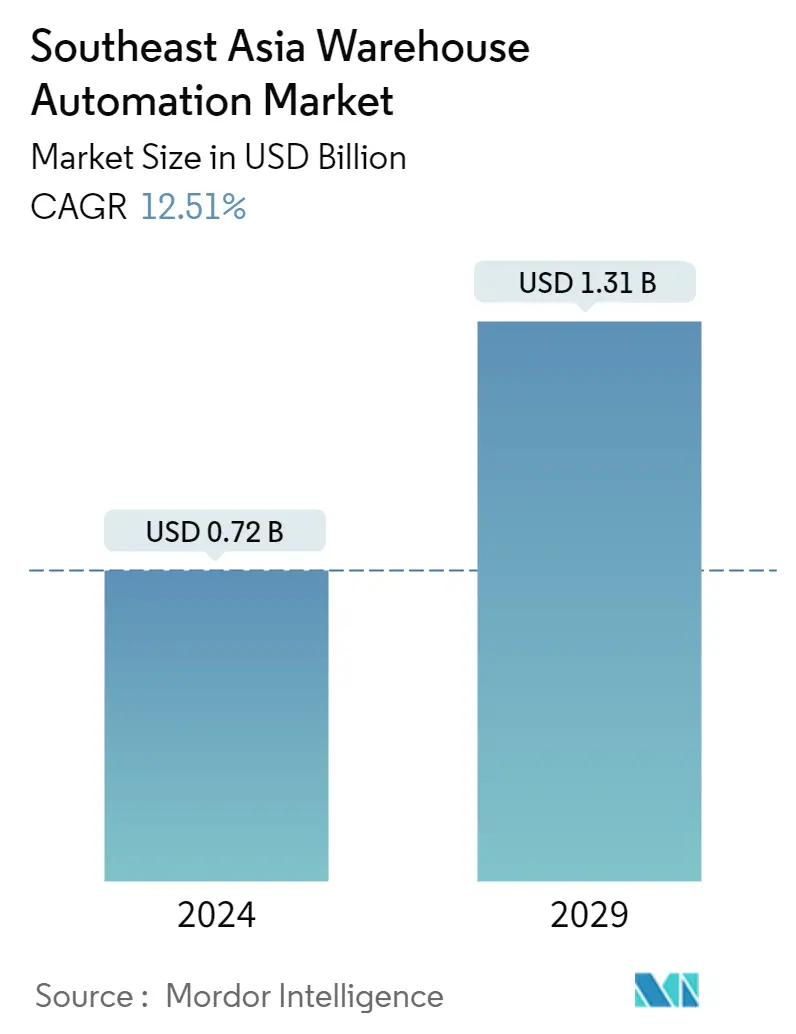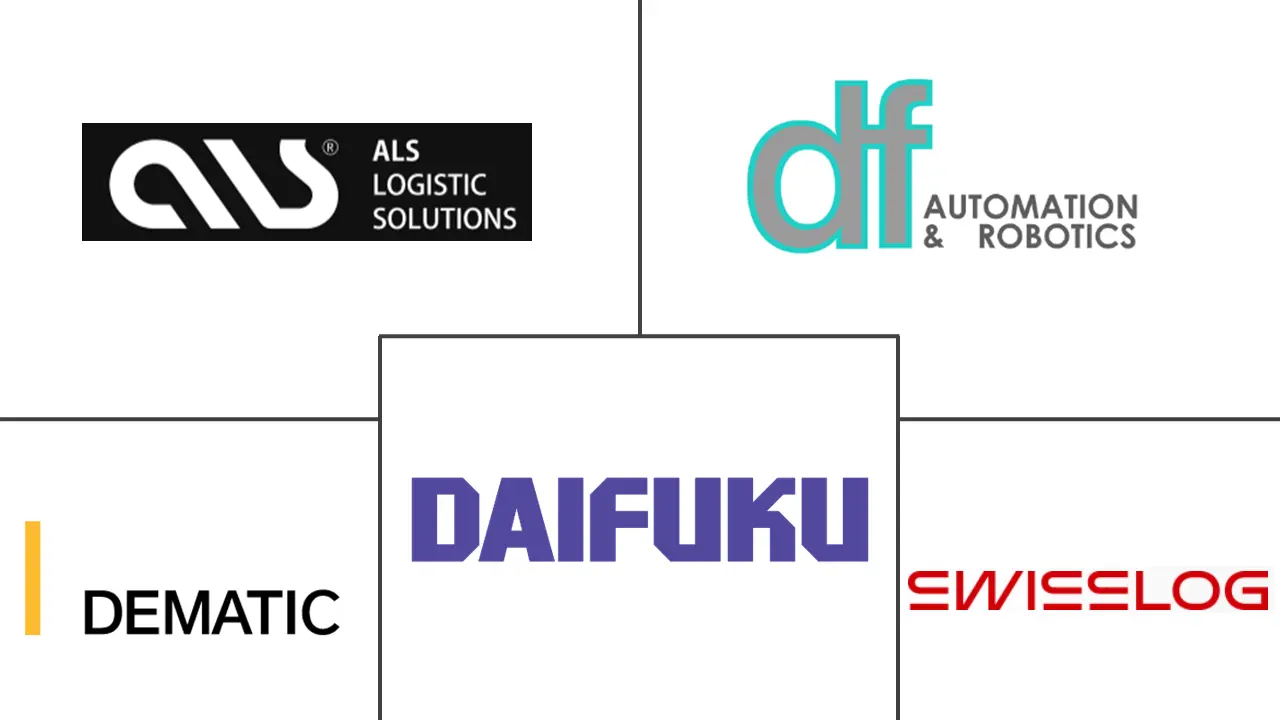
| Study Period | 2019 - 2029 |
| Base Year For Estimation | 2023 |
| Forecast Data Period | 2024 - 2029 |
| Market Size (2024) | USD 0.72 Billion |
| Market Size (2029) | USD 1.31 Billion |
| CAGR (2024 - 2029) | 12.51 % |
| Market Concentration | Low |
Major Players
*Disclaimer: Major Players sorted in no particular order |
Southeast Asia Warehouse Automation Market Analysis
The Southeast Asia Warehouse Automation Market size is estimated at USD 0.72 billion in 2024, and is expected to reach USD 1.31 billion by 2029, growing at a CAGR of 12.51% during the forecast period (2024-2029).
Over the projected period, the market in Southeast Asia will be driven by rising production complexity, technological advancement, and the rapid rise of the e-commerce industry. Furthermore, the emergence of several startup firms with strong technological capabilities and financial backups supports the studied market's growth.
- As investments in automation are prevalent across all industrial markets, warehouse operators are increasingly adopting automation technologies to boost operational efficiency and productivity and minimize handling time. With a range of investment and value-creation opportunities, the studied market is expected to witness steady growth in the next few years.
- The increased volume of e-commerce will drive the industry ahead. Warehouse automation is increasingly establishing the trump card for companies pursuing a competitive edge, especially in the competitive e-grocery market, as traders struggle to keep up with the expanding number of transactions and related last-mile shipping needs. According to the International Trade Administration (ITA), the e-commerce market in Singapore is expected to reach USD 10 billion by 2026.
- Furthermore, Thailand's usage of autonomous guide vehicles in industries and warehouses, especially healthcare, is expected to increase by 60% per annum to over 700,000 units by 2022, according to the International Federation of Robotics, and is expected to increase in the coming years. During the forecast period, the growth of the studied market should be helped by the fact that robotic technology is being used more and more in different industries.
- However, obstacles such as a shortage of experienced workers, high investment, and technical problems associated with warehouse robotics are expected to restrain the Southeast Asia warehouse automation market over the forecast period.
- The COVID-19 outbreak hastened the shift to e-commerce, resulting in a shift in customer behavior. A variety of payment options has also contributed to the online purchase. Following the pandemic, the most significant and rising developments have included micro-fulfillment centers, e-grocery expansion, dark stores, and automated cold storage. Increasing investments by players in these sectors are expected to propel market expansion in the post-covid period. Tee Yih Jia Food Manufacturing Pte Ltd and SSI Schafer, for example, announced in February 2022 the opening of Singapore's largest automation rack-clad high bay warehouse, storing capacity at Tee Yih Jia's newest USD 450 million production plant in Senoko.
Southeast Asia Warehouse Automation Industry Segmentation
Warehouse automation is the automation of the movement of inventory into, within, and out of warehouses for delivery to customers. As part of an automation project, a business can get rid of labor-intensive tasks that call for repetitive physical labor, manual data entry, and analysis. With the help of warehouse automation, users' facilities can more effectively meet customer demand. The initial step involves automating manual processes like data collection and inventory control with a warehouse management system (WMS). These systems integrate with other solutions to efficiently manage and automate tasks across various business and supply chain functions.
The Southeast Asia warehouse automation market is segmented by product type (conveyor/sortation systems, automated storage and retrieval systems (AS/RS), mobile robots, warehouse management systems (WMS), and automatic identification and data capture (AIDC), by end-user industry (retail (including e-commerce), logistics and transportation, automotive, manufacturing, healthcare, and pharmaceutical), and by country (Malaysia, Thailand, Singapore, Indonesia, Vietnam, and the Philippines). The market sizes and forecasts are provided in terms of value (USD) for all the segments.
| Conveyor/Sortation Systems |
| Automated Storage & Retrieval System (AS/RS) |
| Mobile Robots |
| Warehouse Management Systems (WMS) |
| Automatic Identification and Data Capture (AIDC) |
| Retail (including e-commerce) |
| Logistics and Transportation |
| Automotive |
| Manufacturing |
| Healthcare and Pharmaceutical |
| Other End-user Industries |
| Malaysia |
| Thailand |
| Singapore |
| Indonesia |
| Vietnam |
| Philippines |
Southeast Asia Warehouse Automation Market Size Summary
The Southeast Asia warehouse automation market is poised for significant growth, driven by increasing production complexity, technological advancements, and the rapid expansion of the e-commerce sector. The market is characterized by a surge in investments across various industrial sectors, with warehouse operators adopting automation technologies to enhance operational efficiency and productivity. The rise of e-commerce, particularly in the competitive e-grocery market, is a key factor propelling the industry forward. Companies are leveraging automation to gain a competitive edge, especially as they navigate the challenges of increasing transaction volumes and last-mile delivery demands. The market is further supported by the emergence of startups with robust technological capabilities and financial backing, contributing to the overall growth trajectory.
Despite the promising outlook, the market faces challenges such as a shortage of skilled workers, high investment costs, and technical issues related to warehouse robotics. The COVID-19 pandemic has accelerated the shift towards e-commerce, altering consumer behavior and increasing demand for automated solutions like micro-fulfillment centers and automated cold storage. Retail warehouse automation is becoming essential for businesses to streamline logistics, enhance customer satisfaction, and boost revenues. The market is fragmented, with numerous regional and global players engaging in strategic developments to expand their presence. Innovations such as Swisslog's updated mobile robotic platform and new warehouse management systems in countries like the Philippines are indicative of the ongoing advancements in the sector.
Southeast Asia Warehouse Automation Market Size - Table of Contents
1. MARKET DYNAMICS
-
1.1 Market Drivers
- 1.1.1 Exponential Growth of E-commerce
- 1.1.2 Growing Adoption of Automation Across Various Industries
-
1.2 Market Restraints
- 1.2.1 High Initial Equipment Cost
2. MARKET SEGMENTATION
-
2.1 By Product Type
- 2.1.1 Conveyor/Sortation Systems
- 2.1.2 Automated Storage & Retrieval System (AS/RS)
- 2.1.3 Mobile Robots
- 2.1.4 Warehouse Management Systems (WMS)
- 2.1.5 Automatic Identification and Data Capture (AIDC)
-
2.2 By End-user Industry
- 2.2.1 Retail (including e-commerce)
- 2.2.2 Logistics and Transportation
- 2.2.3 Automotive
- 2.2.4 Manufacturing
- 2.2.5 Healthcare and Pharmaceutical
- 2.2.6 Other End-user Industries
-
2.3 By Country
- 2.3.1 Malaysia
- 2.3.2 Thailand
- 2.3.3 Singapore
- 2.3.4 Indonesia
- 2.3.5 Vietnam
- 2.3.6 Philippines
Southeast Asia Warehouse Automation Market Research FAQs
How big is the Southeast Asia Warehouse Automation Market?
The Southeast Asia Warehouse Automation Market size is expected to reach USD 0.72 billion in 2024 and grow at a CAGR of 12.51% to reach USD 1.31 billion by 2029.
What is the current Southeast Asia Warehouse Automation Market size?
In 2024, the Southeast Asia Warehouse Automation Market size is expected to reach USD 0.72 billion.


